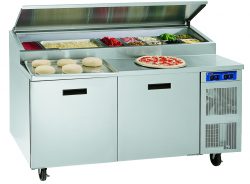 As a manufacturer of preparation tables, we are frequently asked why we no longer make tables that allow flush pans. Here’s the short answer: They don’t hold a consistent temperature. The long answer is more involved and requires an understanding of cold temperatures in commercial cooking applications.
As a manufacturer of preparation tables, we are frequently asked why we no longer make tables that allow flush pans. Here’s the short answer: They don’t hold a consistent temperature. The long answer is more involved and requires an understanding of cold temperatures in commercial cooking applications.
A Change in Regulation
What drove the change from flush pans to recess pans was the 1998 NSF-7 law requiring preparation tables to hold product in the top rail at 41°F or below without freezing the product. Prior to the NSF-7 law, the requirement for food temperatures in the rail was typically 45°F or below. Due to several outbreaks of foodborne illness, it was determined that maximum rail temperatures needed to be lowered by four degrees. This change doesn’t sound like much, but it was a serious challenge for all refrigeration companies.
Faulty Efficiency
Still, there are a few manufacturers who use flush pans. This begs the question: How does a flush pan pass the NSF test even though it’s not nearly as efficient as a recessed pan? The NSF test does not require the pan to be filled to the top; it can be filled to ½” below the rim. But when the temperature is taken ½” below the surface of the food, this adjustment means that the temperature is taken 1″ below the surface of the pan. This modification in measurement creates a recess that holds cold air above the product. The manufacturer can also write in a variance if added to the owner’s manual under operating instructions. This variance could state that the product in the pan must remain 1″ below the pan rim, which would give you a 1-1/2″ recess for the product.
However, when this same unit gets into the field, the pans are often filled to the top or even overflowing, and temperatures are usually measured with an infrared laser on the surface instead of ½” down into the product. In a controlled lab, the flush pan might read that it is holding the temperature, but in the field, it will struggle to pass health inspections.
Testing a New Solution
Once the new requirements were set in place, manufacturers had to find a solution to hold temperatures better. The best way to test was to recess the pans so that cold air would stay over the product and protect it. Because cold air weighs more than hot air, you have to create a “well” (a recess) to hold the cold air above the pans. Without this recess, the cold air will simply find the lowest point. By creating this recess above the pans, a cold “blanket” of air can cover the pans and protect them from ambient conditions.
It is our goal to meet our customers’ foodservice equipment needs while maintaining the highest standards of manufacturing and promoting food safety. We don’t just want our prep tables to pass a test in a lab; we want them to be the best-operating, easiest-to-use, easiest-to-clean, safest temperature-holding prep tables in your kitchen. Most importantly, our mission is to build you a reliable prep table that protects your investment and obtains the performance you desire.
Click here to learn more about the benefits and features of Randell prep tables, or feel free to contact me directly for more information.
Chris Seeburger
Randell Product Specialist
cseeburger@unifiedbrands.net